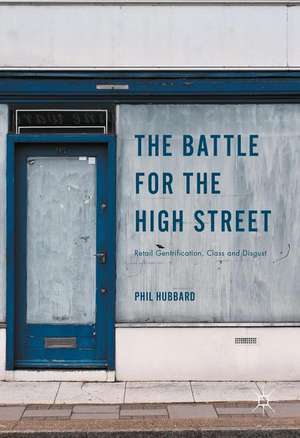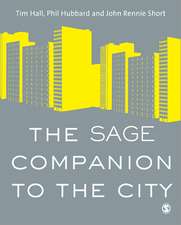The Battle for the High Street: Retail Gentrification, Class and Disgust
Autor Phil Hubbarden Limba Engleză Hardback – 10 feb 2017
This book analyses the social and cultural status of high streets in the age of recession and austerity. High streets are shown to have long been regarded as the heart of many communities, but have declined to a state where boarded-up and vacant retail units are a familiar sight in many British cities. The book argues that the policies deemed necessary to revive the fortunes of high streets are often thinly-veiled attacks on the tastes and cultures of the working class. Policy-makers often promote boutiques, art galleries and upmarket cafés at the expense of some of the outlets frequented by less affluent populations, including betting shops, fast food takeaways, discount stores and bargain booze outlets.
Highlighting the social and cultural roles that so-called 'dying' high streets continue to play in the lives of working class and disadvantaged populations, this book provides a powerful argument against retail gentrification, and a timely analysis of class conflict in austerity Britain. It will be of great interest to scholars of geography, social policy and cultural studies.
| Toate formatele și edițiile | Preț | Express |
|---|---|---|
| Paperback (1) | 450.71 lei 6-8 săpt. | |
| Palgrave Macmillan UK – 22 ian 2019 | 450.71 lei 6-8 săpt. | |
| Hardback (1) | 641.53 lei 6-8 săpt. | |
| Palgrave Macmillan UK – 10 feb 2017 | 641.53 lei 6-8 săpt. |
Preț: 641.53 lei
Preț vechi: 754.74 lei
-15% Nou
Puncte Express: 962
Preț estimativ în valută:
122.76€ • 126.84$ • 102.12£
122.76€ • 126.84$ • 102.12£
Carte tipărită la comandă
Livrare economică 19 martie-02 aprilie
Preluare comenzi: 021 569.72.76
Specificații
ISBN-13: 9781137521521
ISBN-10: 113752152X
Pagini: 255
Ilustrații: X, 260 p. 1 illus. in color.
Dimensiuni: 148 x 210 x 20 mm
Greutate: 0.45 kg
Ediția:1st ed. 2017
Editura: Palgrave Macmillan UK
Colecția Palgrave Macmillan
Locul publicării:London, United Kingdom
ISBN-10: 113752152X
Pagini: 255
Ilustrații: X, 260 p. 1 illus. in color.
Dimensiuni: 148 x 210 x 20 mm
Greutate: 0.45 kg
Ediția:1st ed. 2017
Editura: Palgrave Macmillan UK
Colecția Palgrave Macmillan
Locul publicării:London, United Kingdom
Cuprins
Foreword. Gentrification and Retail Change.- Chapter 1. The 'Death' of the High Street.- Chapter 2. Going Out of Town.- Chapter 3. Reviving the High Street.- Chapter 4. 24-Hour Party People.- Chapter 5. Sexing it Up.- Chapter 6. Place Your Bets.- Chapter 7. Fast Food, Slow Food.- Chapter 8. Bohemia on the High Street.- Chapter 9. Conclusion: Vital and Viable?.
Notă biografică
Phil Hubbard is Professor of Urban Studies at the University of Kent, UK. He is author of several books including Cities and Sexualities (2012), City (2006), People and Place (2001), and The Entrepreneurial City (1998). His research has shed new light on the understanding of social exclusion, marginalization and displacement by showing how urban restructuring profoundly shapes and influences contemporary social life.
Textul de pe ultima copertă
This book analyses the social and cultural status of high streets in the age of recession and austerity. High streets are shown to have long been regarded as the heart of many communities, but have declined to a state where boarded-up and vacant retail units are a familiar sight in many British cities. The book argues that the policies deemed necessary to revive the fortunes of high streets are often thinly-veiled attacks on the tastes and cultures of the working class. Policy-makers often promote boutiques, art galleries and upmarket cafés at the expense of some of the outlets frequented by less affluent populations, including betting shops, fast food takeaways, discount stores and bargain booze outlets.
Highlighting the social and cultural roles that so-called 'dying' high streets continue to play in the lives of working class and disadvantaged populations, this book provides a powerful argument against retail gentrification, and a timely analysis of class conflict in austerity Britain. It will be of great interest to scholars of geography, social policy and cultural studies.
Caracteristici
Offers a timely analysis of the status of high streets in austerity Britain Provokes debate about the social and cultural roles of retail outlets, taking class as an important perspective Draws on original research conducted in several UK towns













